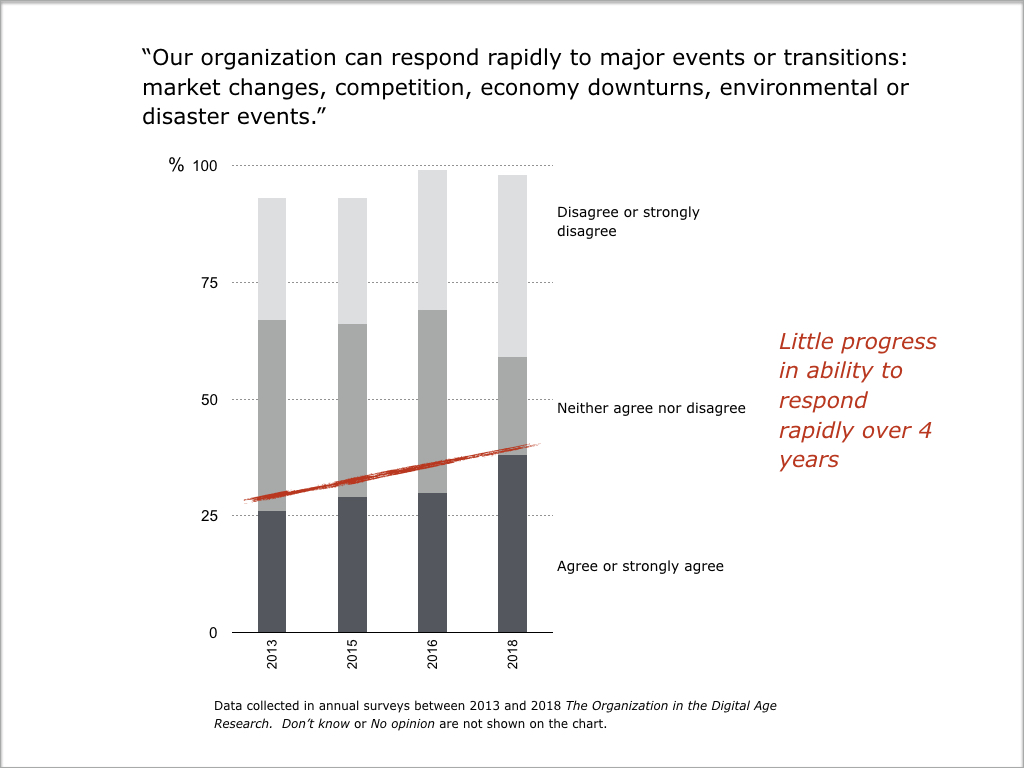Being Resilient


This article is about being resilient. It is not about resilience. A resilient person or organization can get through a crisis. But making it through once is not enough. It is highly likely there will be more and greater disruption in the short- and long-term. We are already living this. Being resilient is a state of readiness, a way of acting, a way of thinking. It is proactive, not reactive. In today’s work environment, this is business critical, for individuals and for organizations. It may even be a question of survival.
In the words of D. Christopher Kayes: “Thinking about resilience when there isn’t a catastrophe going on is one of the hallmarks of a resilient organization… It’s not only about responding to problems, but also about how to get ahead of them in the future”. The British Standards Institution (BSI) visualizes organizational resilience as a race that “has no finish line”.
The BSI conducted a study in 2017 then again in 2019. They identified 16 components of resilience. I am focusing on two of them here:
Comparing the results of their 2017 report with that of 2019 shows a dramatic and critical shift in perceptions, both in importance and performance. The perceived importance of these two interdependent capabilities jumped dramatically between 2017 and 2019 from bottom to the top of the list! However, when asked about their performance, most managers felt they were not good at horizon scanning nor at being able to adapt. Simply said, companies have realized how important it is to be adaptive and that horizon scanning is highly important. They recognize their weakness in both.

I saw the same results in my research between 2013 and 2018 where I asked over 300 organizations over four consecutive years to state their agreement or disagreement with the statement “Our organization can respond rapidly to major events or transitions: market changes, competition, economy downturns, environmental or disaster events.”

The low levels of agree or strongly agree over the 4 years never even come close to 50% of the surveyed organizations. This is worrying.
Interestingly, in 2018 the percentage that agreed increased significantly, as did the percentage that disagreed! A sign perhaps that people are looking at adaptation with a clearer eye. Still, there’s a lot of progress to be made.
Gig-mindset oriented people in general are good at scanning the horizon. It is second nature to them. They have high external awareness and do extensive networking. However, having a few gig-mindset oriented people in the organization is just the starting point. The work culture needs to follow.
We will look briefly at five ways to cultivate a gig mindset culture and thereby a more resilient organization. These topics will be developed in more detail in future articles.
Reverse leadership exists when leaders show wise ignorance, asking others for input. They encourage a spirit of contradiction to ensure that all viewpoints are considered. This is horizon scanning from the inside. Most of all, these leaders stay in the background, invisible, focused on enabling their teams to do their jobs better. Reverse leadership needs to be practiced at all levels of an organization, from team leaders on the edge working with customers to individuals in positions of management high in the hierarchy.
Successful decentralization is built on the foundation of strategic guidelines. People can then make decisions and determine how they work within these agreements. The work culture is one of freedom within a framework. People at the edges, often those serving customers, and home-grown experts–who have learned while doing–are then liberated to play strong roles in decision-making and being accountable for their actions.
Interactions among people, inside and outside the organization, are the primary source of learning. These exchanges lead to fast problem-solving through multi-directional flows of information and experience-sharing. Working out loud is instrumental in learning because it brings visibility to peoples’ work, building a dynamic work culture that increases the capability to adapt.
When one is faced with unexpected and unplanned-for events, improvisation is essential and often the only possible reaction. Improvisation is deliberate, extemporaneous and occurs during action. It’s using what you have at hand in a new way to solve a problem. There is an urgent need, no time to plan, and you must react immediately. This can only happen in organizations where people feel free to experiment in general and failures are shared in a no-blame culture. In this context, people fear no reprisals and are confident and comfortable improvising on the rare occasion when the need arises.
Work-life balance is a rarely recognized criteria for organizational resilience. It is usually considered a personal weakness, inability to stay on top of things. It may happen when people have trouble balancing the demands of work versus personal life. Medical research has shown that it usually comes from the work context and not the individual person. This corresponds to my own research, based on participants’ self-analyses, which suggests that a strong gig mindset reduces the risk of burnout. This is because, when faced with excessive work stress, the gig mindset person feels more in control than does the traditional mindset person who will more quickly feel overwhelmed and out of control. A healthy work-live balance makes both the person and the organization more resilient.

We have reached a point of no return. Digital transformation has enabled a significant increase in peoples’ and organizations’ capabilities, but it can only take us so far. We need a fundamental move towards a more gig-mindset way of thinking and working. The gig mindset tends to be resisted by the organizational immune system because it threatens hierarchy, questions the status quo, and breaks invisible barriers. When people encounter something new, they react in one of three ways: (1) they ignore it, (2) they fight it, or (3) they embrace it. Reactions to the gig-mindset concept are no exception.
We need to (1) fight ignorance by increasing awareness, (2) win the battle through persuasion and examples of benefits and (3) support the people who embrace the gig mindset and help them build momentum and lead us to more meaningful and satisfying ways of working.
Comments are dis-activated here because of spam, but you can pop over to the LinkedIn version of the same article and join the conversation.
For reference you can see here the traditional mindset versus gig mindset behaviors defined by myself and my Advisory Board and studied in the research:
https://netjmc.com/gig-vs-traditional-mindset-8-behaviors/
You can read more about the gig mindset here:
https://www.linkedin.com/pulse/how-gig-mindset-inside-organizations-shape-our-future-jane-mcconnell/
Notes
[i] Professor of management at the George Washington University School of Business in Washington.
[ii] British Standards Institution. Report with the Economist Intelligence Unit entitled “Organizational Resilience”. 2017 (2160 organizations were surveyed.)
Why we should re-examine the clichés in our head
Food for thought from NS Ramnath of Founding Fuel
These ideas have become clichés in part because they are useful. But, the problem is we often end up thinking they always work. They stop us from digging deeper. We get blindsided. We fail to see the downsides. We miss interesting opportunities. The antidote is to consciously seek the opposite.
Very relevant to my work on the gig mindset. Always question the status quo. Do not trust best practices!
I found this article in the FT very useful for rethinking how business students learn.
“Students love the classroom buzz and collaborative approach, but critics are circling.”
In fact, the critics are saying that learning through exploring scenarios, as is the growing practice at Yale, is more relevant today. Business cases, used heavily at Harvard according to the article, are based on the past. This makes sense to me. Best practices may be helpful, but they too are based on the past. Take a look at the article and let me know what you think.
Why Harvard’s case studies are under fire
One of the points I develop in my book on the gig mindset inside organizations is that senior managers today depend too much on best practices, especially those of their peers, and miss seeing what is happening around them on a broader scale.
Nothing matches your request, please try again with a different search term.